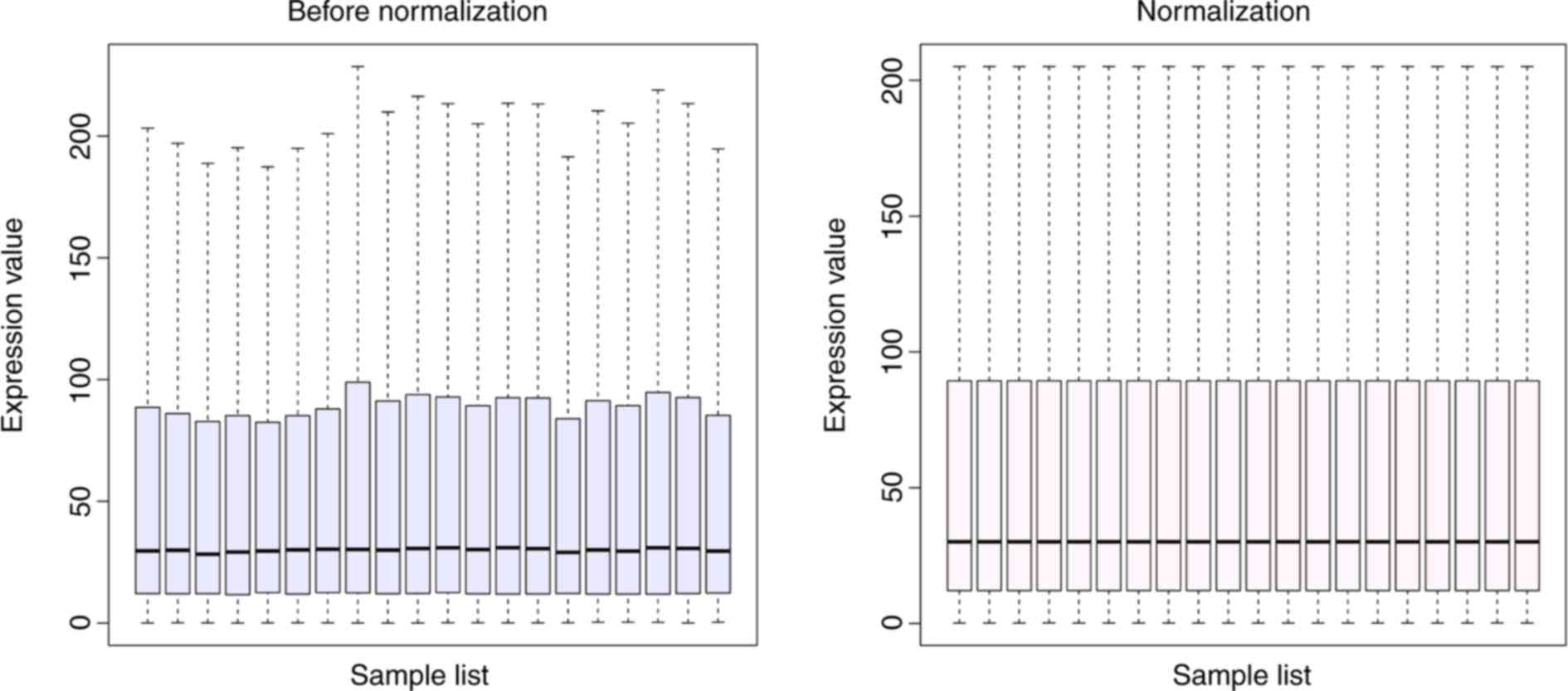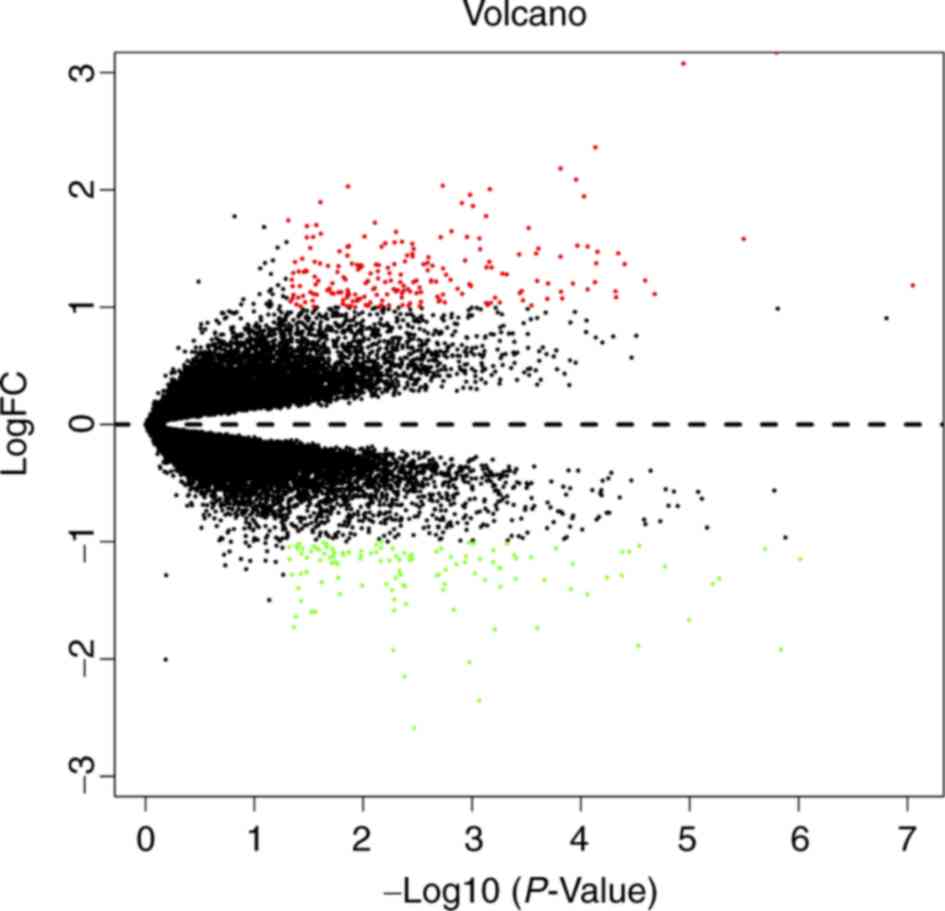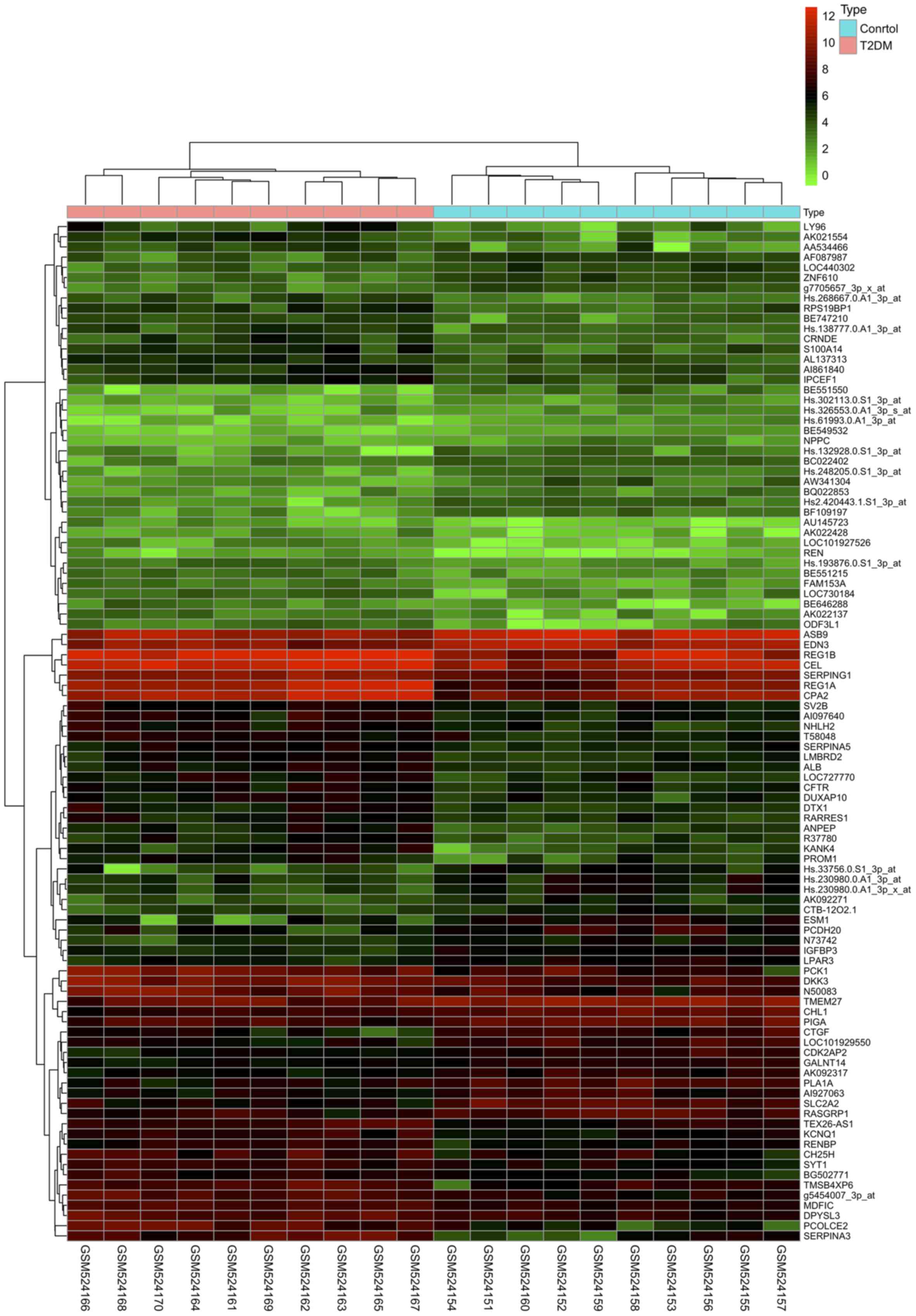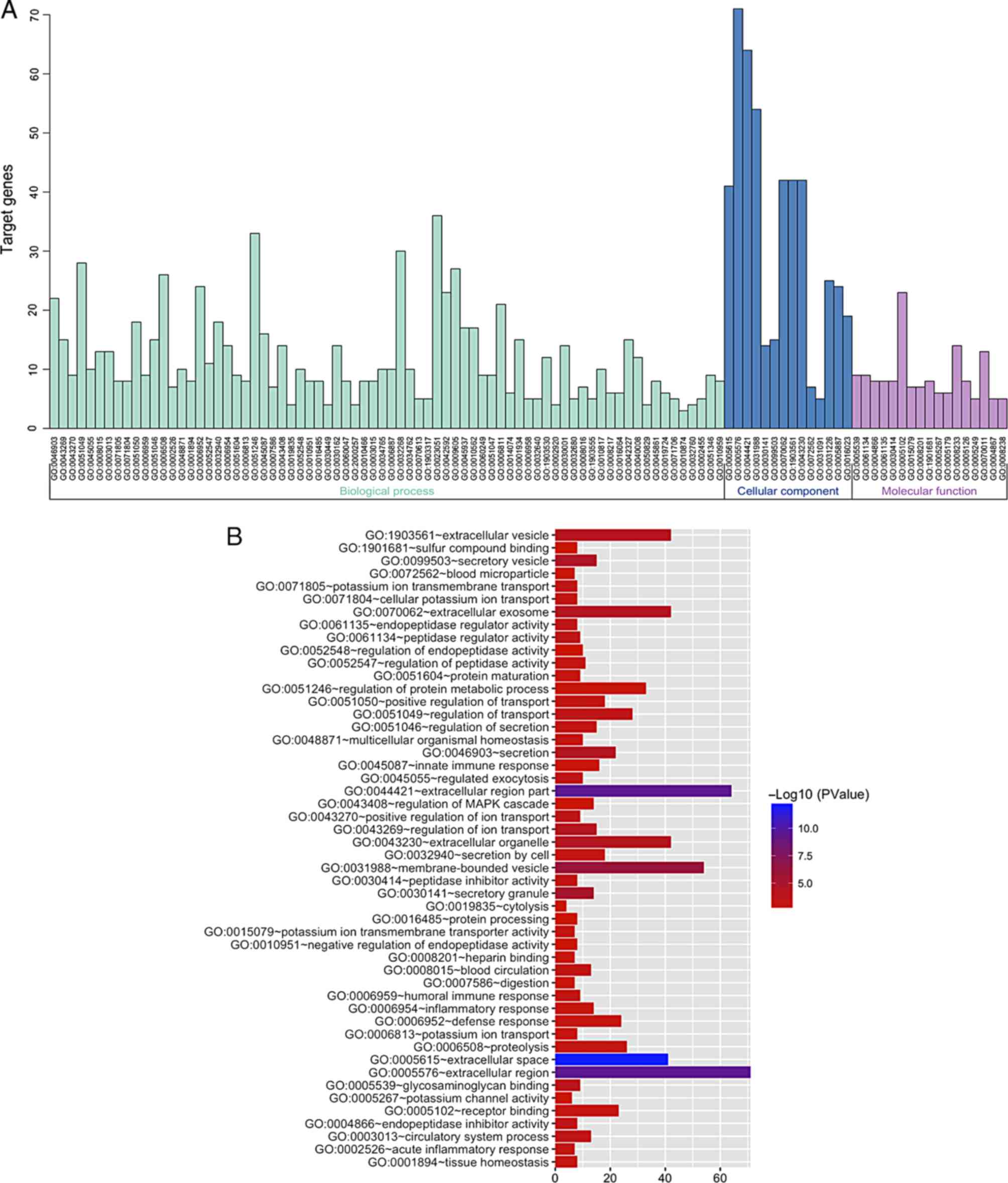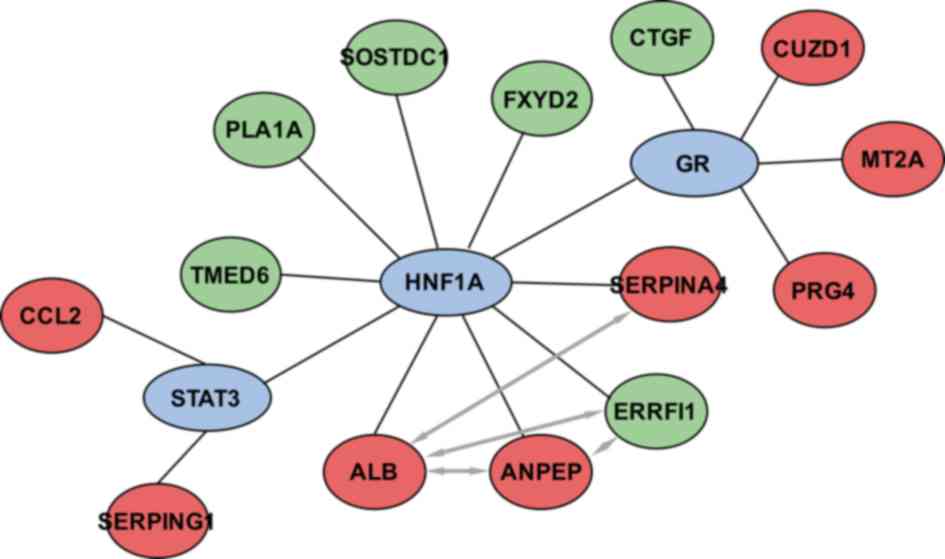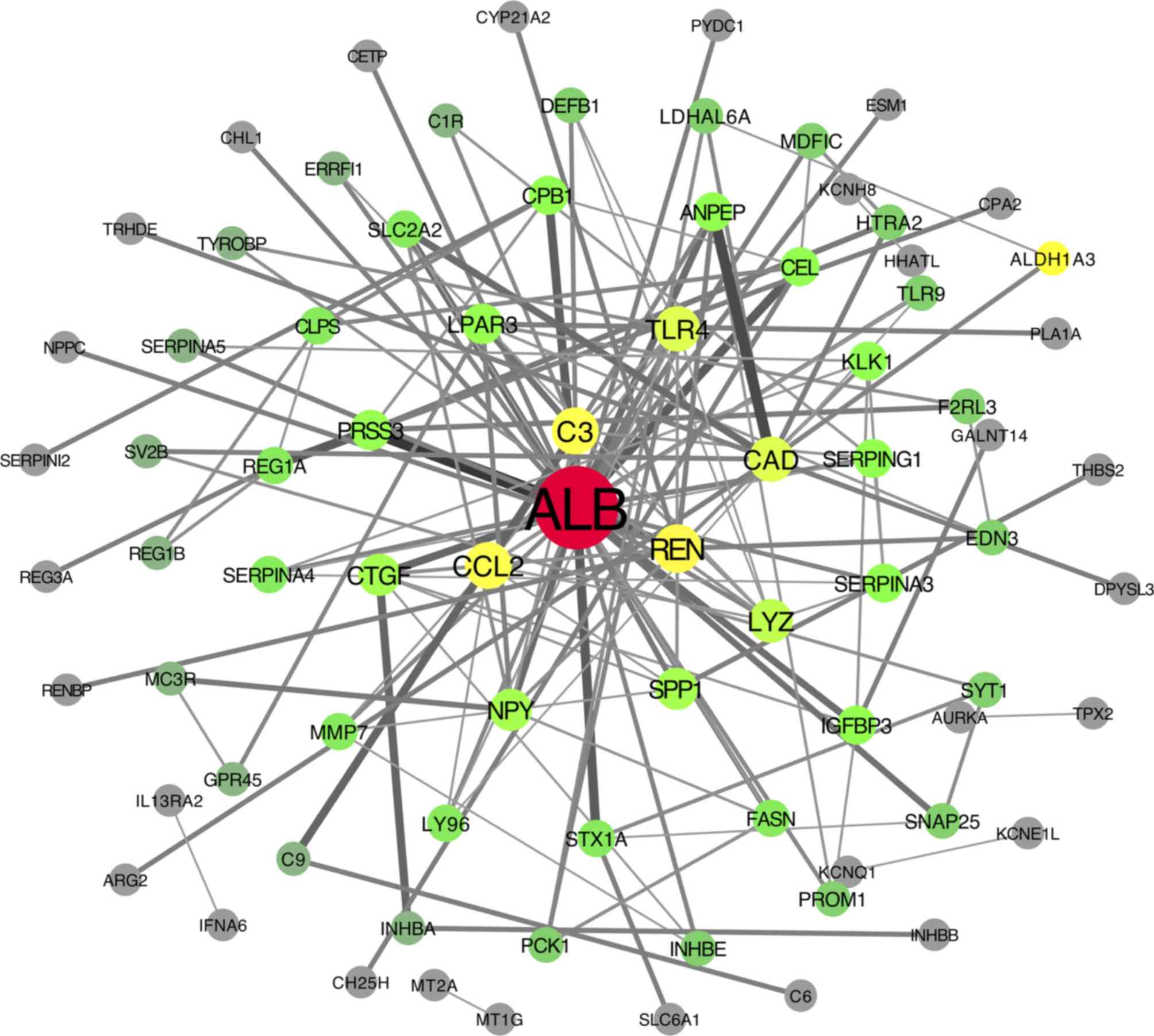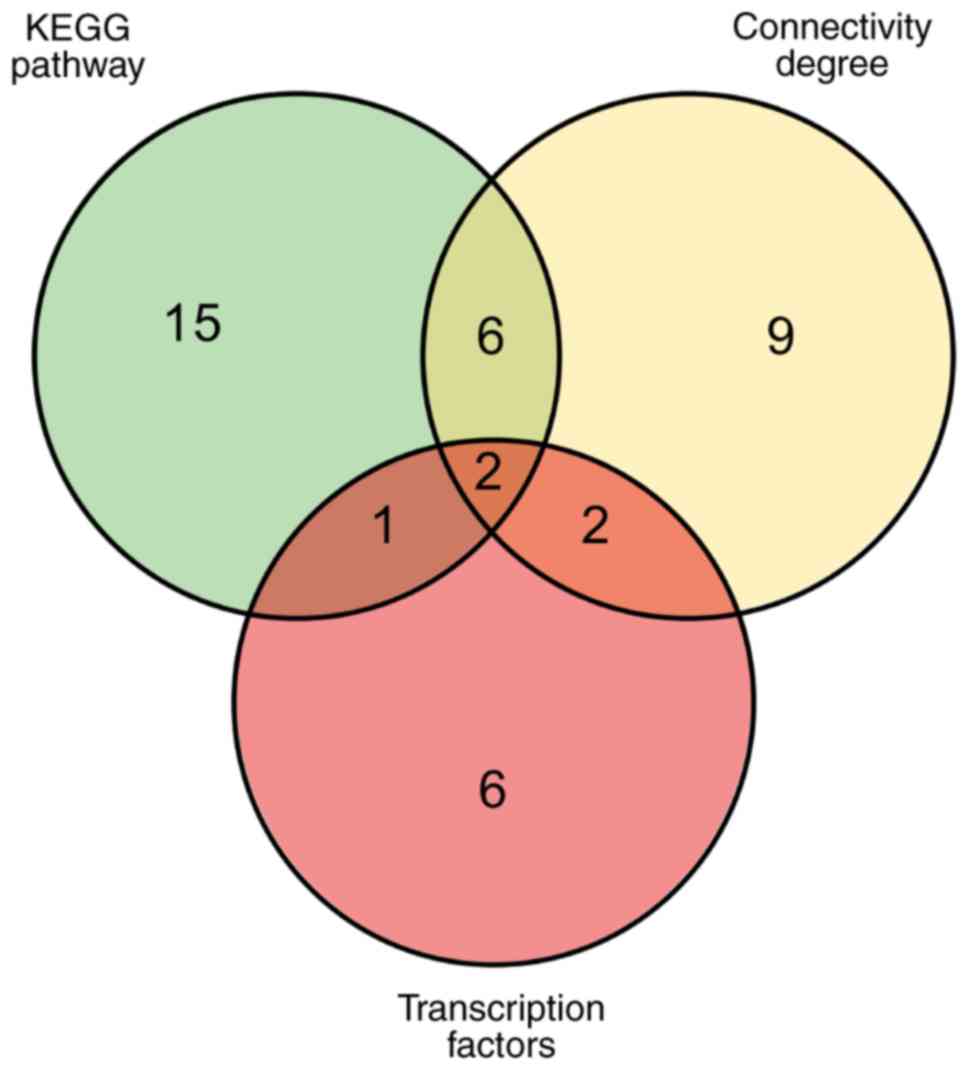Identification of core genes and pathways in type 2 diabetes mellitus by bioinformatics analysis
- Authors:
- Published online on: July 24, 2019 https://doi.org/10.3892/mmr.2019.10522
- Pages: 2597-2608
-
Copyright: © Ding et al. This is an open access article distributed under the terms of Creative Commons Attribution License.
Abstract
Introduction
Type 2 diabetes mellitus (T2DM) is a metabolic disorder characterized by hyperglycemia caused by a relative lack of insulin. The number of cases of T2DM are increasing worldwide and it has become an important health concern. According to a survey by the International Diabetes Federation, the prevalence if T2DM is expected to exceed 10% of the global adult population by 2040 (1). The main causes of T2DM are insulin resistance and an insulin secretion defect. The majority of patients with insulin resistance are obese and exhibit symptoms, such as slight fatigue and thirst in the early stages of T2DM (2). Research suggests that alterations in multiple genes and signaling pathways are involved in regulating the development of T2DM. However, a lack of research on the precise molecular mechanisms of T2DM progression limits the treatment efficacy of the disease at present. Therefore, understanding the molecular mechanisms of T2DM occurrence and development is of utmost importance for non-invasive diagnosis and targeted therapy in the future.
Pancreatic cells, particularly β-cells, play an important role in the occurrence and development of T2DM (3). Initial-phase insulin secretion dysfunction in pancreatic β-cells is the primary feature of T2DM. A number of studies have explored the factors that contribute to impaired pancreatic β-cell function in T2DM, including endoplasmic reticulum stress, lipotoxicity, mitochondrial dysfunction, oxidative stress, low inflammation of islets and glucotoxicity (4,5). For example, Park et al (6) found that the deposition of islet amyloid polypeptide (IAPP) upregulated the Fas receptor of pancreatic β-cells and initiated an apoptotic cascade. Although pancreatic β-cell damage is observed in patients with T2DM, the mechanisms and signaling pathways involved remain unknown. Bioinformatic analysis of microarrays enables the overall analysis of differentially expressed genes (DEGs) in the development of T2DM. Marselli et al (7), gathered pancreatic β-cell samples from tissues by laser capture microdissection (LCM) and detected DEGs between patients with T2DM and normal donors. However, the interactions between DEGs, signal pathway interaction networks and transcription factors (TFs) warrant further comprehensive analysis.
In the present study, we selected GSE20966 from the Gene Expression Omnibus (GEO) database, and used the limma package in R software to screen DEGs. Subsequently, we analyzed the Gene Ontology (GO) functions and Kyoto Encyclopedia of Genes and Genomes (KEGG) pathways associated with the resulting DEGs. Moreover, a protein-protein interaction (PPI) network of the DEGs was established and TFs were selected. We also identified core genes by a comprehensive analysis.
Materials and methods
Microarray profile data
The microarray dataset GSE20966, based on the GPL1352 platform (Affymetrix Human X3P Array), was obtained from the GEO (www.ncbi.nlm.nih.gov/geo/) database. The GSE20966 dataset was provided by Marselli et al, who collected pancreatic β cells by LCM (7). In addition, 10 non-diabetic samples and 10 diabetic samples were used in the microarray.
Identification of DEGs
The original CEL GSE20966 data were pre-processed into expression estimates and background correction was then performed. A CEL file generated by a scanner that contains the processing intensity values for each spot. The intensity of each spot indicates the binding intensity of the probe to the gene. The impute package was used to predict the expression values of genes that were not measured. This imputation method is based on the KNN (k-nearest neighbor) algorithm. The KNN method searches for other genes with similar expression profiles to the genes with missing values, and the missing values are then filled in using the expression values of these similar genes (8). The normalizeBetweenArrays function in the limma package was applied to normalize the intensity of expression (9). Then, t-tests were performed in the limma package to identify DEGs. The threshold value for DEGs was selected by a P-value <0.05 and |log2 fold change (FC)| ≥1.
GO function and KEGG pathway analyses
Functional annotation tools were provided by the Database of Annotation, Visualization and Integrated Discover (DAVID, david.abcc.ncifcrf.gov/) to comprehend the biological function of the genes. GO function analysis was applied to annotate DEGs from biological processes (BP), cellular components (CC) and molecular functions (MF), and KEGG was applied to annotate the DEG pathways. Subsequently, we selected the false discovery rate (FDR) as a screening criterion, to limit the FDR to an acceptable range while testing as many positive results as possible.
TF enrichment analysis
The Enrichr (amp.pharm.mssm.edu/lib/chea.jsp) and WebGestalt software (www.webgestalt.org/option.php) were applied to select key TFs involved in the regulation of DEGs in T2DM. The threshold value of enrichment was selected by a P-value <0.05. Significant TFs that regulated the DEGs were selected.
PPI network construction and analysis
Since proteins rarely perform biological functions independently, it is important to be aware of protein interactions by studying functional groups. A PPI network was established by the STRING app (http://apps.cytoscape.org/apps/stringapp) in Cytoscape software version 3.6.0. The software used the default parameters for analysis, and the connectivity degree of each node in the network was calculated by connectivity analysis. DEGs with a degree of connectivity ≥5 were defined as having high degrees of connectivity and were used to screen for core genes.
Screening for core genes
Core genes were identified using the following 3 conditions: i) participation in the enriched KEGG pathways; ii) calculated to have a high degree of connectivity; and iii) a target gene of key TFs.
Cells and cell culture
The mouse pancreatic β-cell line, MIN-6, was obtained from the American Type Culture Collection (ATCC). The low-glucose group cultured in low-glucose Dulbecco's modified Eagle's medium (Thermo Fisher Scientific, Inc.) with 15% fetal bovine serum (Thermo Fisher Scientific, Inc.), 1% antibiotics (100 U/ml penicillin; 100 U/ml streptomycin) and 5 µM 2-Mercaptoethanol (Sigma-Aldrich Co., LLC). In addition to the same components as the low-glucose group, the high-glucose group additionally dissolved α-D-glucose (Solarbio) at a final concentration of 25 mM in the medium. All cells cultured in the atmosphere containing 5% CO2 at 37°C for 2 weeks.
RNA isolation and reverse transcription-quantitative polymerase chain reaction (RT-qPCR)
Total RNA was extracted from the 2 groups with using PureLink™ RNA Mini kit (Thermo Fisher Scientific, Inc.) according to the manufacturer's protocol. RNA quality was detected by Nanodrop 2000 (Thermo Fisher Scientific, Inc.). The synthesis of cDNA was using a SuperScript IV first-strand cDNA synthesis kit (Thermo Fisher Scientific, Inc.) according to the RT-PCR manufacturer's protocol. qPCR was performed with an ABI StepOnePlus™ system (Thermo Fisher Scientific, Inc.) using the PowerUp™ SYBR™-Green Master Mix kit (Thermo Fisher Scientific, Inc.). The cycling conditions were as follows: UDG activation 50°C for 2 min; denaturation 95°C for 2 min; followed by 40 cycles of 95°C for 15 sec; 60°C for 1 min; 62°C for 1 min. The primer sequences were as follows: Alanyl aminopeptidase, membrane (ANPEP) forward, ATGGAAGGAGGCGTCAAGAAA and reverse, CGGATAGGGCTTGGACTCTTT; serpin family G member 1 (SERPING1) forward, TAGAGCCTTCTCAGATCCCGA and reverse, ACTCGTTGGCTACTTTACCCA; and GAP DH forward, AGGTCGGTGTGAACGGATTTG and reverse, TGTAGACCATGTAGTTGAGGTCA. The relative expression of ANPEP and SERPING1 were normalized to GAPDH and analyzed using the 2−ΔΔCq method (10).
Statistical analysis
Statistical analyses were performed in GraphPad Prism 8.0 software (GraphPad Software, Inc.). Statistical analysis in this study was performed by two-tailed Student's t-tests. The data from each group are expressed as the means ± standard error of the mean, and a P-value <0.05 was considered to represent a statistically significant difference.
Results
Identification of DEGs
The results of standardizing the microarray gene expression are displayed in Fig. 1. This process yields the intensities in a set of arrays similar distributions. The expression dataset was selected using the limma package (P-value <0.05, |log2 FC| ≥1) in R software. Overall, 329 DEGs were obtained, including 208 upregulated and 121 downregulated genes. A volcano diagram was constructed for the DEGs and is presented in Fig. 2. The top 100 DEGs are presented by a cluster heatmap in Fig. 3.
GO function and KEGG pathway analysis
GO functional analysis and KEGG enrichment pathway analysis in the DAVID online software were applied for a deeper comprehension of the identified DEGs. The GO functional analysis of the DEGs was divided into 3 functional groups, including BP, CC MF. The significant results are presented in Fig. 4 and Table I. In the BP group, the upregulated genes were mainly clustered in defense response, regulated exocytosis and the acute inflammatory response, and the downregulated genes were mainly clustered in regulation of ion transport, heart contraction and heart process. For the CC group, the upregulated genes were primarily clustered in extracellular space, extracellular region part, and extracellular region. The downregulated genes were primarily clustered in extracellular space and extracellular region, as well as a cluster of actin-based cell projections. The upregulated genes in the MF group were mostly clustered in peptidase regulator activity, endopeptidase inhibitor activity, and endopeptidase regulator activity, and the downregulated genes were mostly clustered in insulin-like growth factor binding, growth factor binding, and channel regulator activity.
The top significantly enriched KEGG pathways for the DEGs were also displayed by the DAVID online software and are presented in Table II. The upregulated genes were associated with pancreatic secretion and the complement and coagulation cascades, while the downregulated genes were involved in carbohydrate digestion and absorption, insulin secretion, and the Toll-like receptor (TLR) signaling pathway.
TF enrichment analysis
Key TFs that are associated with T2DM were identified by WebGestalt and Enrichr software. The results revealed that hepatocyte nuclear factor 1-alpha (HNF1A), signal transducer and activator of transcription 3 (STAT3) and glucocorticoid receptor (GR) were involved in the regulation of the DEGs. As shown in Fig. 5, HNF1A, STAT3 and GR regulate 8, 2 and 4 DEGs, respectively, in pancreatic β-cells.
PPI network construction and module screening
The DEG expression products in T2DM were constructed into PPI networks using the STRING app in Cytoscape software. By removing the separated and separately connected nodes, a complex network of DEGs was constructed and is presented in Fig. 6. Cytoscape software was applied to calculate the connectivity of each node in the PPI network. Twenty DEGs were selected by a degree of connectivity ≥5. The degrees of connectivity of all nodes are shown in Table III.
Screening for core genes
The Venn diagram presented in Fig. 7 illustrates the overlaps between DEGs that are involved in the enriched KEGG pathways, that exhibit a high degree of connectivity, and that are regulated by key TFs. When comparing genes in the KEGG pathways and with a high degree of connectivity, there were 6 overlapping genes: Carboxyl ester lipase (CEL), serine protease 3 (PRSS3), carboxypeptidase B1 (CPB1), complement C3 (C3), renin (REN) and kallikrein 1 (KLK1). When comparing genes in the KEGG pathways and those regulated by key TFs, the overlapping gene was FXYD domain containing ion transport regulator 2 (FXYD2). When comparing genes with a high degree of connectivity and those regulated by key TFs, there were 2 overlapping genes: Albumin (ALB) and C-C motif chemokine ligand 2 (CCL2). Finally, two core genes were identified that were present for all three conditions: SERPING1 and ANPEP.
Identification of ANPEP and SERPING1 expression
To investigate the expression ANPEP and SERPING1, and expression was assessed by comparing the high-glucose group with the low-glucose group. The results of RT-qPCR indicated that ANPEP (P-value <0.01) and SERPING1 (P-value <0.05) were expressed at a higher level in the high=glucose group compared with the low-glucose group (Fig. 8). These findings indicate that ANPEP and SERPING1 may be associated with high glucose levels in pancreatic β-cells.
Discussion
The rapid development of high-throughput sequencing technology allows biological problems to be addressed by gene sequencing. Currently, high-throughput sequencing is beginning to be widely used to find candidate genes for numerous diseases. Since the pathogenesis of T2DM is not clear, comprehension of the molecular mechanisms of T2DM is required for non-invasive diagnosis and targeted therapies.
Laser capture microdissection (LCM) technology has been utilized to extract samples. LCM obtains target cells directly from frozen or paraffin-embedded tissue sections without destroying the surrounding tissue morphology. It is often utilized to accurately separate individual cells from tissue (11). The accurate separation of pancreatic β-cells from heterogeneous tissue is a prerequisite for continuous and meaningful bioinformatic analysis. Marselli et al gathered pancreatic β-cells from patients with T2DM and healthy controls by LCM for microarray analysis. In this study, we extracted the expression data from GSE20966, and identified 208 upregulated and 121 downregulated DEGs by bioinformatic analysis. To further investigate the interactions between the DEGs, GO function and KEGG pathway enrichment analyses were performed.
The GO analysis indicated that the upregulated DEGs were primarily involved in the defense response, regulated exocytosis, and the acute inflammatory response, while the downregulated DEGs were primarily associated with regulation of ion transport, heart contraction and process and the regulation of signaling. Insulin resistance and pancreatic β-cell structural dysfunction are caused by an inflammatory response and lead to the development of T2DM (12,13). Moreover, the knockdown of the Na+/K+ ATPase subunit FXYD2 in the ion transport pathway improved mouse pancreatic β-cell proliferation and glucose tolerance (14,15). Furthermore, the enriched KEGG pathways of the upregulated DEGs were involved in pancreatic secretion and the complement and coagulation cascades. The complement pathway is primarily related to host defense and inflammation (16). The expression of C1q and C5a in the complement pathway are associated with diabetic vascular complications, such as diabetic retinopathy and diabetic nephropathy (17,18). The downregulated DEGs were primarily involved in carbohydrate digestion and absorption, insulin secretion and the TLR pathway. Solute carrier family 2 member 2 (SLC2A2) was associated with carbohydrate digestion, absorption pathway and the insulin secretion pathway. SLC2A2, also known as glucose transporter 2 (GLUT2), is the transmembrane carrier protein that transports glucose primarily in the liver and blood (19). SLC2A2 can detect the presence of extracellular sugar and signal to regulate insulin secretion by the pancreatic β-cells (20). Mutation of the SLC2A2 gene conveys a high risk for the conversion of impaired glucose tolerance (IGT) patients to T2DM patients (21). The TLR pathway can promote the synthesis of many cellular activity factors, adhesion molecules and inflammatory factors, ultimately affecting immunity and the inflammatory response (22). The TLR pathway is associated with the pathogenesis and development of diabetes (23). Intercellular adhesion molecule-1 (ICAM-1) exhibits an upregulated expression in the retinal e ndothelial cells of diabetic retinopathy rats. Through the accumulation and adhesion of leukocytes, ICAM-1 can cause retinal vascular damage and destroy the blood-retinal barrier (24). Rajamani and Jiala found that TLR2 and TLR4 expression were upregulated in hyperglycemia-induced human microvascular retinal endothelial cells (HMVRECs), and activated NF-κB to produce biomediators of inflammation and ICAM-1 (25). Therefore, these pathways are most likely to be important in the development of diabetes and diabetic complications. Additional studies are required to identify all the DEGs in T2DM.
The primary function of TFs is to bind a specific site of a gene and regulate the expression of the target gene in the cell. In this study, the TFs, HNF1A, STAT3 and GR, were shown to be potential modulators of T2DM. HNF1A belongs to the HNF1 homeobox family, and HNF1A is essential for the regulation of pancreatic β-cell differentiation. The I27L polymorphism of HNF1A decreases β-cell mass or impairs function and leads to a high risk of T2DM (26,27). HNF1A is a key transcription factor mediating the expression of dipeptidyl peptidase-4 (DPP4) and angiotensin converting enzyme 2 (ACE2) in pancreatic β-cells, both of which may have therapeutic potential for T2DM (28,29). Notably, ACE2 expression activates STAT3, shown herein to be an important TF. The activation of the JAK/STAT3 pathway has been reported to encourage the development of vasculopathy in T2DM (30). However, Tiano et al concluded that the activation of STAT3 signaling inhibits the synthesis and accumulation of fatty acids in pancreatic cells of diabetic mice induced by a high-fat diet, thus preventing pancreatic β-cell damage (31). In addition, STAT3 signaling activation has been demonstrated to enhance the function of insulin secretion (32). This indicates that STAT3 is a double-edged sword in the development of T2DM, preventing the pancreatic cells from further damage and maintaining the secretion of insulin, while aggravating the development of vascular complications. GR, also known as NR3C1, is the receptor bound by cortisol and other glucocorticoids. Recent studies have demonstrated that the Bcl1 polymorphism in intron 2 of GR is associated with insulin resistance and hyperinsulinemia, although the underlying mechanisms remain unclear (33,34). Therefore, additional research is required to explore the role of GR in T2DM insulin resistance.
In this study, we also constructed a PPI network for the DEGs, and there were 4 genes with a connectivity level ≥10: ALB, REN, C3 and CCL2. ALB was the DEG with the highest degree of connectivity. The serum glycated ALB level in patients with T2DM is related to coronary artery disease (CAD). As the level of serum glycated ALB increases, the presence and severity of CAD increases (35,36). Rodiño-Janeiro et al also reported that the elevated expression of glycated ALB upregulated NAPDH oxidase in vitro, and the enhanced oxidative stress may mediate diabetic vasculopathy (37). REN is important in the development of diabetic vasculopathies, such as diabetic retinopathy and diabetic nephropathy (38,39). A subsequent study using biopsy samples from diabetic patients revealed that renin plays a role in diabetic vascular disease by activating a renin-angiotensin system (40). In this study, we found that the gene expression of C3 (log2 FC=1.44, P-value <0.01) was upregulated in pancreatic β-cells of patients with T2DM. In the complement signaling pathway, C3 is a key protein in both the alternative pathway and the classical pathway. Elevated rates of diabetes and insulin resistance are closely related to increased serum C3 (41–43). The main feature of T2DM is pancreatic β-cell damage and dysfunction, due to a shift of β-cell status from proliferative to apoptotic (44). Notably, a recent study demonstrated that C3 stimulated intracellular calcium and ATP levels by activating the C3/C3aR signaling pathway, and increased glucose-dependent insulin secretion and protection against apoptosis (45). Dos Santos et al also reported that C3 silencing led to apoptosis under normal physiological conditions and following exposure to cytokines. The addition of exogenous C3 prevents cytokine-induced apoptosis in β cells through C3-mediated activation of the AKT signaling pathway and inhibition of c-Jun N-terminal kinase activity (46). Therefore, it is conceivable that elevated C3 may have a protective effect on apoptosis in T2DM, indicating that C3 may be a potential therapeutic target for T2DM. CCL2 belongs to the CC chemokine family, and is also known as monocyte chemoattractant protein 1 (MCP1). In vitro studies on patients with proliferative diabetic retinopathy have demonstrated that the level of CCL2 is significantly increased in patients compared with healthy controls (47). Liu et al found that hyperglycemia may affect hypomethylation of the CpG site in the CCL2 promoter region, and enhanced differential expression of serum CCL2 was important in the occurrence and development of vasculopathy in T2DM (48). Recent studies have proposed that the CCL2 2518A/G polymorphism is associated with diabetic retinopathy in T2DM; as the number of G alleles increased, the prevalence of diabetic retinopathy was elevated (47,49).
In the present study, we identified two core genes, SERPING1 and ANPEP. SERPING1, also known as the C1-inhibitor (C1INH), is a protease inhibitor that belongs to the SERPIN superfamily. The STAT3 signaling pathway regulates the expression of SERPING1. The function of SERPING1 is to inhibit activation of both the classical pathway and the lectin pathway to reduce production of C3 convertase. Notably, the expression levels of SERPING1 and C3 were both upregulated in this study, indicating that the activation of the complement system may be achieved by the alternative pathway. The accumulation of C3 in vivo is probably caused by the effect of SERPING1 inhibiting C3 convertase. We hypothesized that the STAT3 signaling pathway stimulates the expression of SERPING1 and promotes the accumulation of C3 to produce an anti-apoptotic effect in pancreatic β-cells. Moreover, the SERPING1-mediated regulation of the complement pathway may inhibit the inflammatory response in pancreatic β-cells. Thus, SERPING1 may play a dual role, an anti-inflammatory one, while maintaining an anti-apoptotic effect. Further studies are required to confirm this hypothesis. ANPEP, a broadly specific aminopeptidase, is associated with a number of cellular process, including cell proliferation, apoptotic differentiation, angiogenesis, and chemotaxis (50). The results presented in Fig. 5 suggest that HNF1A simultaneously regulates the expression of ANPEP and ALB, and that there is an interaction between ALB and ANPEP. Expression of ALB stimulates the production of reactive oxygen species (ROS) by the NADPH enzyme to activate oxidative stress (37). The expression levels of both ANPEP and REN in our study are upregulated. Both of them activate the renin-angiotensin signaling pathway to stimulate ROS generation. Pancreatic β cells are more sensitive to ROS, and so this can lead to direct damage of pancreatic β cells and promote apoptosis. Therefore, we suggest that HNF1A-mediated ANPEP and ALB expression may accelerate pancreatic β-cell damage and insulin resistance through oxidative stress. Pedersen et al compared the direct overlap between heterogeneous islet diabetes-associated genomes by genome-wide association studies (GWAS) to establish ANPEP as a diabetes susceptibility gene (51). Locke et al found that ANPEP had a significant allelic expression imbalance by comparing the allelic expression of RNA and DNA from islets of diabetic and non-diabetic individuals. This suggests that ANPEP is a pathogenic gene for T2DM (52). However, the precise mechanisms of action of ANPEP in T2DM remain unknown, and further research is required to confirm this hypothesis. In our further studies, we aim to validate the selected SERPING1 and ANPEP genes in T2DM tissue samples from patients and animal models.
In conclusion, in the present study, we conducted a thorough bioinformatics analysis of DEGs by GSE20966 data screening and identified several genes implicated in the development and progression of T2DM. A total of 329 genes were identified, of which SERPING1 and ANPEP are probable core genes of T2DM. This study reveals a series of valuable genes for further research into the non-invasive diagnosis and targeted therapy of T2DM. However, bioinformatics analyses merely indicate a general direction for further research. To confirm the functions of DEGs in T2DM, molecular biology experiments are required.
Acknowledgements
Not applicable.
Funding
The present study was supported by Medical Health Science and Technology Project of Zhejiang Provincial Health Commission (No. 2019RC300), Jinhua Municipal Science and Technology Project (No. 2018-4-036) and Youth Foundation of Jinhua Municipal Central Hospital (No. JY-2017-1-01).
Availability of data and materials
The datasets used or analyzed during the present study are available from the corresponding author on reasonable request.
Authors' contributions
LD and YX designed the experiments. LF and XX performed the experiments. JF analyzed the data. All authors have read and approved the final manuscript.
Ethics approval and consent to participate
This analysis was based on a previously published study and no ethical approval and patient consent is required.
Patient consent for publication
Not applicable.
Competing interests
The authors declare that they have no competing interests.
References
|
Ogurtsova K, da Rocha Fernandes JD, Huang Y, Linnenkamp U, Guariguata L, Cho NH, Cavan D, Shaw JE and Makaroff LE: IDF diabetes atlas: Global estimates for the prevalence of diabetes for 2015 and 2040. Diabetes Res Clin Pract. 128:40–50. 2017. View Article : Google Scholar : PubMed/NCBI | |
|
Zhao Q, Zhang A, Zong W, An N, Zhang H, Luan Y, Sun H, Wang X and Cao H: Exploring potential biomarkers and determining the metabolic mechanism of type 2 diabetes mellitus using liquid chromatography coupled to high-resolution mass spectrometry. RSC Adv. 7:441862017. View Article : Google Scholar | |
|
Leibowitz G, Kaiser N and Cerasi E: Balancing needs and means: The dilemma of the beta-cell in the modern world. Diabetes Obes Metab. 11 (Suppl 4):S1–S9. 2009. View Article : Google Scholar | |
|
Hoshino A, Ariyoshi M, Okawa Y, Kaimoto S, Uchihashi M, Fukai K, Iwai-Kanai E, Ikeda K, Ueyama T, Ogata T and Matoba S: Inhibition of p53 preserves Parkin-mediated mitophagy and pancreatic β-cell function in diabetes. Proc Natl Acad Sci USA. 111:3116–3121. 2014. View Article : Google Scholar : PubMed/NCBI | |
|
Chaurasia B and Summers SA: Ceramides-lipotoxic inducers of metabolic disorders. Trends Endocrinol Metab. 26:538–550. 2015. View Article : Google Scholar : PubMed/NCBI | |
|
Park YJ, Lee S, Kieffer TJ, Warnock GL, Safikhan N, Speck M, Hao Z, Woo M and Marzban L: Deletion of Fas protects islet beta cells from cytotoxic effects of human islet amyloid polypeptide. Diabetologia. 1–Feb;2012.(Epub ahead of print). View Article : Google Scholar : | |
|
Marselli L, Thorne J, Dahiya S, Sgroi DC, Sharma A, Bonner-Weir S, Marchetti P and Weir GC: Gene expression profiles of beta-cell enriched tissue obtained by laser capture microdissection from subjects with type 2 diabetes. PLoS One. 5:e114992010. View Article : Google Scholar : PubMed/NCBI | |
|
Troyanskaya O, Cantor M, Sherlock G, Brown P, Hastie T, Tibshirani R, Botstein D and Altman RB: Missing value estimation methods for DNA microarrays. Bioinformatics. 17:520–525. 2001. View Article : Google Scholar : PubMed/NCBI | |
|
Bolstad BM, Irizarry RA, Astrand M and Speed TP: A comparison of normalization methods for high density oligonucleotide array data based on variance and bias. Bioinformatics. 19:185–193. 2003. View Article : Google Scholar : PubMed/NCBI | |
|
Livak KJ and Schmittgen TD: Analysis of relative gene expression data using real-time quantitative PCR and the 2(-Delta Delta C(T)) method. Methods. 25:402–408. 2001. View Article : Google Scholar : PubMed/NCBI | |
|
Espina V, Wulfkuhle JD, Calvert VS, VanMeter A, Zhou W, Coukos G, Geho DH, Petricoin EF III and Liotta LA: Laser-capture microdissection. Nat Protoc. 1:586–603. 2006. View Article : Google Scholar : PubMed/NCBI | |
|
Lontchi-Yimagou E, Sobngwi E, Matsha TE and Kengne AP: Diabetes mellitus and inflammation. Curr Diab Rep. 13:435–444. 2013. View Article : Google Scholar : PubMed/NCBI | |
|
Velloso LA, Eizirik DL and Cnop M: Type 2 diabetes mellitus-an autoimmune disease? Nat Rev Endocrinol. 9:750–755. 2013. View Article : Google Scholar : PubMed/NCBI | |
|
Arystarkhova E, Liu YB, Salazar C, Stanojevic V, Clifford RJ, Kaplan JH, Kidder GM and Sweadner KJ: Hyperplasia of pancreatic beta cells and improved glucose tolerance in mice deficient in the FXYD2 subunit of Na,K-ATPase. J Biol Chem. 288:7077–7085. 2013. View Article : Google Scholar : PubMed/NCBI | |
|
Arystarkhova E: Beneficial renal and pancreatic phenotypes in a mouse deficient in FXYD2 regulatory subunit of Na,K-ATPase. Front Physiol. 7:882016. View Article : Google Scholar : PubMed/NCBI | |
|
Markiewski MM and Lambris JD: The role of complement in inflammatory diseases from behind the scenes into the spotlight. Am J Pathol. 171:715–727. 2007. View Article : Google Scholar : PubMed/NCBI | |
|
Huang C, Fisher KP, Hammer SS, Navitskaya S, Blanchard GJ and Busik JV: Plasma exosomes contribute to microvascular damage in diabetic retinopathy by activating classical complement pathway. Diabetes. 67:1639–1649. 2018. View Article : Google Scholar : PubMed/NCBI | |
|
Flyvbjerg A: The role of the complement system in diabetic nephropathy. Nat Rev Nephrol. 13:311–318. 2017. View Article : Google Scholar : PubMed/NCBI | |
|
Uldry M and Thorens B: The SLC2 family of facilitated hexose and polyol transporters. Pflugers Arch. 447:480–489. 2004. View Article : Google Scholar : PubMed/NCBI | |
|
Laukkanen O, Lindström J, Eriksson J, Valle TT, Hämäläinen H, Ilanne-Parikka P, Keinänen-Kiukaanniemi S, Tuomilehto J, Uusitupa M and Laakso M; Finnish Diabetes Prevention Study, : Polymorphisms in the SLC2A2 (GLUT2) gene are associated with the conversion from impaired glucose tolerance to type 2 diabetes: The finnish diabetes prevention study. Diabetes. 54:2256–2260. 2005. View Article : Google Scholar : PubMed/NCBI | |
|
Leturque A, Brot-Laroche E and Le Gall M: GLUT2 mutations, translocation, and receptor function in diet sugar managing. Am J Physiol Endocrinol Metab. 296:E985–E992. 2009. View Article : Google Scholar : PubMed/NCBI | |
|
Takeda K, Kaisho T and Akira S: Toll-like receptors. Annu Rev Immunol. 21:335–376. 2003. View Article : Google Scholar : PubMed/NCBI | |
|
Dasu MR, Devaraj S, Zhao L, Hwang DH and Jialal I: High glucose induces toll-like receptor expression in human monocytes: Mechanism of activation. Diabetes. 57:3090–3098. 2008. View Article : Google Scholar : PubMed/NCBI | |
|
Miyahara S, Kiryu J, Yamashiro K, Miyamoto K, Hirose F, Tamura H, Katsuta H, Nishijima K, Tsujikawa A and Honda Y: Simvastatin inhibits leukocyte accumulation and vascular permeability in the retinas of rats with streptozotocin-induced diabetes. Am J Pathol. 164:1697–1706. 2004. View Article : Google Scholar : PubMed/NCBI | |
|
Rajamani U and Jialal I: Hyperglycemia induces Toll-like receptor-2 and −4 expression and activity in human microvascular retinal endothelial cells: Implications for diabetic retinopathy. J Diabetes Res. 2014:7909022014. View Article : Google Scholar : PubMed/NCBI | |
|
Chiu KC, Chuang LM, Chu A, Yoon C and Wang M: Comparison of the impact of the I27L polymorphism of the hepatocyte nuclear factor-1alpha on estimated and measured beta cell indices. Eur J Endocrinol. 148:641–647. 2003. View Article : Google Scholar : PubMed/NCBI | |
|
Morita K, Saruwatari J, Tanaka T, Oniki K, Kajiwara A, Otake K, Ogata Y and Nakagawa K: Associations between the common HNF1A gene variant p.I27L (rs1169288) and risk of type 2 diabetes mellitus are influenced by weight. Diabetes Metab. 41:91–94. 2015. View Article : Google Scholar : PubMed/NCBI | |
|
Gu N, Tsuda M, Matsunaga T, Adachi T, Yasuda K, Ishihara A and Tsuda K: Glucose regulation of dipeptidyl peptidase IV gene expression is mediated by hepatocyte nuclear factor-1alpha in epithelial intestinal cells. Clin Exp Pharmacol Physiol. 35:1433–1439. 2008.PubMed/NCBI | |
|
Pedersen KB, Chhabra KH, Nguyen VK, Xia H and Lazartigues E: The transcription factor HNF1α induces expression of angiotensin-converting enzyme 2 (ACE2) in pancreatic islets from evolutionarily conserved promoter motifs. Biochim Biophys Acta. 1829:1225–1235. 2013. View Article : Google Scholar : PubMed/NCBI | |
|
Banes-Berceli AK, Ketsawatsomkron P, Ogbi S, Patel B, Pollock DM and Marrero MB: Angiotensin II and endothelin-1 augment the vascular complications of diabetes via JAK2 activation. Am J Physiol Heart Circ Physiol. 293:H1291–H1299. 2007. View Article : Google Scholar : PubMed/NCBI | |
|
Tiano JP, Delghingaro-Augusto V, Le May C, Liu S, Kaw MK, Khuder SS, Latour MG, Bhatt SA, Korach KS, Najjar SM, et al: Estrogen receptor activation reduces lipid synthesis in pancreatic islets and prevents β cell failure in rodent models of type 2 diabetes. J Clin Invest. 121:3331–3342. 2011. View Article : Google Scholar : PubMed/NCBI | |
|
Ezzat S, Zheng L, Florez JC, Stefan N, Mayr T, Hliang MM, Jablonski K, Harden M, Stančáková A, Laakso M, et al: The cancer-associated FGFR4-G388R polymorphism enhances pancreatic insulin secretion and modifies the risk of diabetes. Cell Metab. 17:929–940. 2013. View Article : Google Scholar : PubMed/NCBI | |
|
Geelen CC, van Greevenbroek MM, van Rossum EF, Schaper NC, Nijpels G, 't Hart LM, Schalkwijk CG, Ferreira I, van der Kallen CJ and Sauerwein HP: BclI glucocorticoid receptor polymorphism is associated with greater body fatness: The Hoorn and CODAM studies. J Clin Endocrinol Metab. 98:E595–E599. 2013. View Article : Google Scholar : PubMed/NCBI | |
|
Syed AA, Halpin CG, Irving JA, Unwin NC, White M, Bhopal RS, Redfern CP and Weaver JU: A common intron 2 polymorphism of the glucocorticoid receptor gene is associated with insulin resistance in men. Clin Endocrinol (Oxf). 68:879–884. 2008. View Article : Google Scholar : PubMed/NCBI | |
|
Lu L, Pu LJ, Xu XW, Zhang Q, Zhang RY, Zhang JS, Hu J, Yang ZK, Lu AK, Ding FH, et al: Association of serum levels of glycated albumin, C-reactive protein and tumor necrosis factor-alpha with the severity of coronary artery disease and renal impairment in patients with type 2 diabetes mellitus. Clin Biochem. 40:810–816. 2007. View Article : Google Scholar : PubMed/NCBI | |
|
Jin C, Lu L, Zhang RY, Zhang Q, Ding FH, Chen QJ and Shen WF: Association of serum glycated albumin, C-reactive protein and ICAM-1 levels with diffuse coronary artery disease in patients with type 2 diabetes mellitus. Clin Chim Acta. 408:45–49. 2009. View Article : Google Scholar : PubMed/NCBI | |
|
Rodiño-Janeiro BK, González-Peteiro M, Ucieda-Somoza R, González-Juanatey JR and Alvarez E: Glycated albumin, a precursor of advanced glycation end-products, up-regulates NADPH oxidase and enhances oxidative stress in human endothelial cells: Molecular correlate of diabetic vasculopathy. Diabetes Metab Res Rev. 26:550–558. 2010. View Article : Google Scholar : PubMed/NCBI | |
|
Ichihara A, Sakoda M, Mito-Kurauchi A and Itoh H: Activated prorenin as a therapeutic target for diabetic nephropathy. Diabetes Res Clin Pract. 82 (Suppl 1):S63–S66. 2008. View Article : Google Scholar : PubMed/NCBI | |
|
Yokota H, Nagaoka T, Tani T, Takahashi A, Sato E, Kato Y and Yoshida A: Higher levels of prorenin predict development of diabetic retinopathy in patients with type 2 diabetes. J Renin Angiotensin Aldosterone Syst. 12:290–294. 2011. View Article : Google Scholar : PubMed/NCBI | |
|
Kamiyama M, Urushihara M, Morikawa T, Konishi Y, Imanishi M, Nishiyama A and Kobori H: Oxidative stress/angiotensinogen/renin-angiotensin system axis in patients with diabetic nephropathy. Int J Mol Sci. 14:23045–23062. 2013. View Article : Google Scholar : PubMed/NCBI | |
|
Engström G, Hedblad B, Eriksson KF, Janzon L and Lindgärde F: Complement C3 is a risk factor for the development of diabetes: A population-based cohort study. Diabetes. 54:570–575. 2005. View Article : Google Scholar : PubMed/NCBI | |
|
Yang S, Li Q, Song Y, Tian B, Cheng Q, Qing H, Zhong L and Xia W: Serum complement C3 has a stronger association with insulin resistance than high-sensitivity C-reactive protein in women with polycystic ovary syndrome. Fertil Steril. 95:1749–1753. 2011. View Article : Google Scholar : PubMed/NCBI | |
|
Wlazlo N, van Greevenbroek MM, Ferreira I, Feskens EJ, van der Kallen CJ, Schalkwijk CG, Bravenboer B and Stehouwer CD: Complement factor 3 is associated with insulin resistance and with incident type 2 diabetes over a 7-year follow-up period: The CODAM study. Diabetes Care. 37:1900–1909. 2014. View Article : Google Scholar : PubMed/NCBI | |
|
Ribbing J, Hamrén B, Svensson MK and Karlsson MO: A model for glucose, insulin, and beta-cell dynamics in subjects with insulin resistance and patients with type 2 diabetes. J Clin Pharmacol. 50:861–872. 2010. View Article : Google Scholar : PubMed/NCBI | |
|
Atanes P, Ruz-Maldonado I, Pingitore A, Hawkes R, Liu B, Zhao M, Huang GC, Persaud SJ and Amisten S: C3aR and C5aR1 act as key regulators of human and mouse β-cell function. Cell Mol Life Sci. 75:715–726. 2018. View Article : Google Scholar : PubMed/NCBI | |
|
Dos Santos RS, Marroqui L, Grieco FA, Marselli L, Suleiman M, Henz SR, Marchetti P, Wernersson R and Eizirik DL: Protective role of complement C3 against cytokine-mediated β-cell apoptosis. Endocrinology. 158:2503–2521. 2017. View Article : Google Scholar : PubMed/NCBI | |
|
Nawaz MI, Van Raemdonck K, Mohammad G, Kangave D, Van Damme J, Abu El-Asrar AM and Struyf S: Autocrine CCL2, CXCL4, CXCL9 and CXCL10 signal in retinal endothelial cells and are enhanced in diabetic retinopathy. Exp Eye Res. 109:67–76. 2013. View Article : Google Scholar : PubMed/NCBI | |
|
Liu ZH, Chen LL, Deng XL, Song HJ, Liao YF, Zeng TS, Zheng J and Li HQ: Methylation status of CpG sites in the MCP-1 promoter is correlated to serum MCP-1 in Type 2 diabetes. J Endocrinol Invest. 35:585–589. 2012.PubMed/NCBI | |
|
Ninomiya H, Katakami N, Osonoi T, Saitou M, Yamamoto Y, Takahara M, Kawamori D, Matsuoka TA, Yamasaki Y and Shimomura I: Association between new onset diabetic retinopathy and monocyte chemoattractant protein-1 (MCP-1) polymorphism in Japanese type 2 diabetes. Diabetes Res Clin Pract. 108:e35–e37. 2015. View Article : Google Scholar : PubMed/NCBI | |
|
Mina-Osorio P: The moonlighting enzyme CD13: Old and new functions to target. Trends Mol Med. 14:361–371. 2008. View Article : Google Scholar : PubMed/NCBI | |
|
Pedersen HK, Gudmundsdottir V and Brunak S: Pancreatic islet protein complexes and their dysregulation in type 2 diabetes. Front Genet. 8:432017. View Article : Google Scholar : PubMed/NCBI | |
|
Locke JM, Hysenaj G, Wood AR, Weedon MN and Harries LW: Targeted allelic expression profiling in human islets identifies cis-regulatory effects for multiple variants identified by type 2 diabetes genome-wide association studies. Diabetes. 64:1484–1491. 2015. View Article : Google Scholar : PubMed/NCBI |



